Phnom Penh Itinerary for 5 Days in Cambodia & Best Getaway from Singapore
Looking for the best getaway from Singapore? Or a city to add to your Asian travel? Two hours in the air brings you from Singapore to the heart of Cambodia. From Siem Reap, Hanoi, Ho Chi Minh City and many other Asian destinations, it’s a 1-2 hour flight to Phnom Penh. 5 Days in Cambodia is the perfect amount of time to explore Phnom Penh. This Phnom Penh itinerary will show you how to experience the history, culture and food of this vibrant city during your Cambodian vacation.
Phnom Penh Orientation
With a population of 1.5 million people, Phnom Penh is the capital of Cambodia. It is the political, business and cultural center of the country. Located at the intersection of the Bassac, Tonle Sap and Mekong Rivers, Phnom Penh is an important shipping and commercial area. Tourism is growing in the city and there is plenty to see and do.
The currency is the Cambodian reil, though US dollars are accepted everywhere. The language is Khmer. Most people need a visa to enter Cambodia. If you enter at Phnom Penh or Siem Reap, it is easy to get on arrival. Smaller places of entry may not have visa capabilities.
Phnom Penh is warm all the time. It is cooler from November to January (70-90F or 21-32C) and hottest from February to May (can be over 100F or 40C). The rainy season is from May to October. High season for tourism runs during dry season is from November to May.
Phnom Penh is more than 700 years old. After Angkor Thom was invaded by the Siam (modern day Thailand), Phnom Penh was founded and served as the capital from 1434 to 1505. It was then abandoned for 360 years until 1866 when it became the capital again. The French arrived in 1863 and colonized Cambodia until 1953. Cambodia, Laos and Vietnam made up French Indochina.

Why go to Phnom Penh?
Many travelers go to Siem Reap to see the wonder of Angkor Wat. We did too. It is truly spectacular and a testimony to the strength and beauty of the people of Cambodia. And, to its long history. But, Angkor Wat was built 900 years ago. There is a lot of history since then that needs to be seen and grappled with.
We wanted to go to Cambodia to see Phnom Penh, the Genocide Museum and the Killing Fields as a way of paying tribute to those that died and share what happened.
Humanity is capable of great destruction. We are also capable of creating great beauty. And, we are capable of building new possibilities out of all of that.
We discovered that there is much more to Phnom Penh than the Killing Fields and Genocide. The City is full of culture, history and many other things.
We want to recognize the growth of the Cambodia people and to contribute in whatever ways we could by spreading the word and supporting the continued growth of Phnom Penh.
The soul of Cambodia lies in Phnom Penh.
Best Places to See in Phnom Penh
Phnom Penh has a wide range of things to do from the more serious killing fields and the genocide museum to night markets, the National Museum, the Royal Palace and Sisowath Quay along the Tonle Sap River.
Below are 10 things that you must see in Phnom Penh. The City can easily be seen on a long weekend, though a 5 day itinerary allows for experiencing Phnom Penh more deeply as well as day trips to the countryside.
After this section, you will find our itinerary suggestions for 1-5 days trips.

Royal Palace and Silver Pagoda
Built in the 1860s, the Royal Palace is the residence of the King of Cambodia. Visiting the Royal Palace is one of the most popular things to do in Phnom Penh.
The Palace is divided into 4 areas: the Silver Pagoda, the Khemarin Palace, the Throne Hall and the Inner Court. Since the Palace is still the residence of the King, there are areas that are closed to visitors.
There are extensive murals depicting the Reamker story (Cambodia’s version of the Indian classic Ramayana also found in the Angkor Wat complex) around the courtyard.

The grounds are beautiful and there are many temples and buildings to see. Among the most impressive is the Silver Pagoda (also known as Wat Preah Keo or the Temple of the Emerald Buddha).
Originally constructed in 1892, the Silver Pagoda was rebuilt in 1962. The floor is made up of silver tiles (5,000 of them). You can see a small part of the silver floor. There is a golden Buddha with more than 2000 diamonds. It is very impressive, though also disconcerting given the poverty of the country.
Address & Hours: The Royal Palace (Samdach Sothearos Blvd 3) and Silver Pagoda (Oknha Chhun St 240). Admission is $10UDS each ($20UD total for both). It is open from 8am – 5pm.
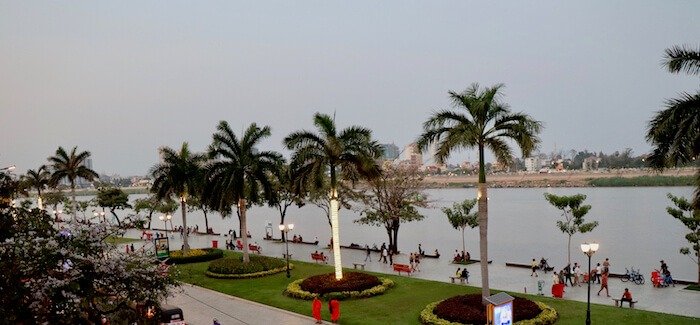
Sisowath Quay and Tonle Sap River
Sisawath Quay, a 3km strip, runs along the Tonle Sap River. Just before nightfall, people gather along the river—tourists mix with locals, monks and children—and vendors sell food and trinkets. People eat, socialize, exercise, dance, pray and watch the boats go by. There are some very small Temples on the strip. You can catch the sun setting behind the Royal Palace from Sisowath Quay. Boat tours along the river are also a popular activity.
Address: along the river across from the Royal Palace

Wat Phnom
Wat Phnom was built in 1372 and is the tallest Temple in Phnom Penh. We were lucky to be there during the Buddhist Festival of Meak Bochea (Visak Bochea Day) which commemorates the final sermon given by the Buddha. It’s a day of penitence and making offerings.
The Temple was crowded with monks receiving offerings, people praying/chanting and leaving offerings. At the end of the day, we jumped out of our tuk tuk to see a large procession of Buddhist monks and devotees praying and chanting while they proceeded through the City.
Address & Hours: Preah Norodom Blvd 41. Foreigners pay US$1 to enter the temple.
Markets in Phnom Penh: Central Market, Russian Market, Night Market
You must go to at least one market in Phnom Penh. They are crowded and full of activity. Most have local food wither inside or outside. They all have a mix of local goods, souvenirs, and food.
Phnom Penh Night Market
We visited the Phnom Penh Night market several times as our first hotel was across the street. The night market is frequented by tourists and locals. It has music, food and lots of shopping. It begins at around 6 pm every night.
Go to the back of the market for dinner, there are freshly cooked noodles and grilled meats for offer by vendors. We selected meats and prawns to be grilled, got some fried noodles and then sat on mats on the floors along with other Cambodian families and tourists. The vendors bring the food to you after it’s cooked. We enjoyed our dinner while being entertained by the local musicians. Some stalls have little tables and chairs for those who didn’t like sitting on the mats.
Address & Hours: Preah Sisowath Quay between Streets 106 and 108. From 6 pm onward.

Russian Market
The Russian Market sells every kind of food and goods you can imagine. It is crowded, dimly lit with narrow aisles. The Toul Tom Poung neighborhood surrounding it has become a draw as well.
Address & Hours: Street 163 and corner of Street 444
Central Market
The Central Market is the largest in Phnom Penh. Built over a former swamp area in 1937, it was bombed by the Thai in the early 1940s and rebuilt by the French in 2011. If you buy things at the Central market, expect to pay tourists prices and bargaining can be difficult.
Visiting Information: Street 128 (Kampuchea Krom) in Phsar Thmei 1 Commune, Daun Penh District. It’s open daily from 6.30 a.m. to 5.30 p.m. There’s a taxi stand near the northwest corner of the market, and a bus stop near the southwest exit.
Address & Hours: Calmette Street 53
Daughters of Cambodia
Daughters of Cambodia is a must do in Phnom Penh. Founded in 2007 by Ruth Elliot, a British Psychologist, Daughters of Cambodia supports male and female sex workers to leave the industry by giving them the opportunity to learn a trade.
DoC provides medical and social work services, creativity programs, education and life skills training. Women learn jewelry making, sewing, doing manicures and pedicures and cooking/food service skills. They are then employed by Daughters of Cambodia or find a job in the community. The program is a faith-based program.
More recently, they have founded Sons of Cambodia for transgendered men.
Overlooking the Tonle Sap River, the Visitors Center has a café, boutique, spa offering massage, pedicures and manicures all staffed by the women. The Center is a wonderful stop in the middle of hectic Phnom Penh.
Address & Hours: 321 Preah Sisowath Quay. Open from 9 am-5 pm.
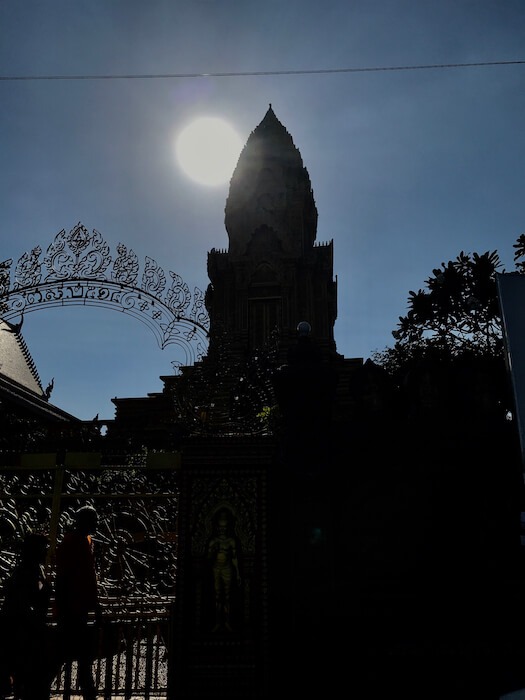
Wat Ounalom
Built in 1443, Wat Ounalom is the center of Buddhism in Cambodia. There are 44 buildings in the Wat and the head of Buddhism lives at Wat Ounalom. There is a statue of Huot Tat, one of the most important Cambodian Buddhist leaders. He was killed by the Khmer Rouge.
There is a stupa behind the main temple that holds the Buddha’s eyebrow hair. The stupa is 500 years old and has 4 bronze statues of the Buddha.
Address & Hours: Ly Yoat Lay St 172, a few steps from Daughters of Cambodia, near the Royal Palace and across from the Mekong. Open from 6 am-8 pm.

Other Sites in Phnom Penh
You can also go to Wat Langka, the Independence Monument, the Statue of Norodom Sihanouk and the Cambodia-Vietnam Monument during your explorations around the city. There are some nice parks in these areas and places for a picnic. In the evenings, many Cambodians gather in these spots to play games and relax.
Tuol Sleng Genocide Museum and the Killing Fields
The Last two sites on our Top 10 list are Tuol Sleng Genocide Museum and the Killing Fields. In order to understand these two places, you need to understand the history first.
Phnom Penh History: The Khmer Rouge
The history of the Khmer Rouge and genocide lingers in the city and the people.

The Communist Party of Cambodia, called the Khmer Rouge, ruled from 1975-1979. General Secretary, Pol Pot aimed to re-create Cambodia as a self-sufficient, collectivized and agrarian society.
In Phnom Penh, the professionals, artists and the educated were either immediately killed in the Phnom Penh killing fields or detained and tortured in the infamous S-21 Prison (now the Tuol Sleng Genocide Museum). Others were moved into the countryside and died of starvation when the agrarian policies failed. Those that could, fled the country. Between 1.5 and 3 million (25% of the population) Cambodians were killed.
In 1979, the Vietnamese invaded Cambodia and many Khmer Rouge leaders fled to the border of Thailand. The Khmer Rouge was recognized as the government in exile by the UN and many western countries until 1993. Very few Khmer Rouge leaders were ever arrested and only were 2 tried for crimes against humanity. In 1998, Pol Pot died while under house arrest.
This history still lives on in the Cambodians. It has taken decades to rebuild its educational and artistic communities. While young people are not taught this history in school, most have grandparents and parents that experienced it or were killed during the genocide.
Preparing to Visit the Tuol Sleng Genocide Museum and Killing Fields
Tuol Sleng Genocide Museum and Killing Fields are a challenging and emotional experience. The Khmer Rouge was brutal in its effort to create a self-sufficient and agrarian Cambodia free from all foreign influences.
People were tortured and executed for the crime of wearing glasses, having “soft hands,” being artistic, being an ethnic minority, being a monk and not being 100% Khmer. Most ended up in the Killing Fields with or without having been tortured at S-21 Prison first. Most of those that went to S-21 were actually members of the Khmer Rouge. There are an estimated 20,000 mass graves in Cambodia.
We had originally planned to do the Tuol Sleng Genocide Museum and Killing Fields on two separate days. We ended up doing it in one day and would recommend that as that is the journey that many Cambodians tragically made.
Tuol Sleng Genocide Museum
The Tuol Sleng Genocide Museum is the former site of the S-21 Prison. It was originally a high school, turned into a torture and interrogation center by the Khmer Rouge.
14,000 people entered. 7 survived.

If you don’t want to have a guide, then definitely get the audio tour. The audio tour walks you through the building with narration about the Khmer Rouge, torture, killings and some of the people that were held at S-21. The audio tour is long and it is hard to make it through the entire narration. It is graphic and will make your heart weep.
In the courtyard, you will likely meet survivors of S-21. When we were there, we met Bou Meng and Dr. Kok-Thay Eng. Dr. Eng was a child in the prison while his parents were there. Bou Meng was an artist. His wife Ma Yoeun was killed at the Killing Fields. Meng was kept alive to paint portraits of Pol Pot and other Khmer leaders. Many of the paintings one the walls of the Genocide Museum were done by Meng.
The audio tour is graphic and not appropriate for young children.
Address & Hours: Tuol Sleng Genocide Museum – St 113, Phnom Penh, entrance fee US$8 includes audio tour, hours are 7am-5.30pm
Choeung Ek Killing Fields
There are more than 20,000 Killing Fields throughout Cambodia. The Choeung Ek Killing Fields are located about 30 minutes outside of Phnom Penh. If you’ve gone to Tuol Sleng Genocide Museum first, then you will be familiar with what happened at the Killing Fields.

After a 30 minute tuk-tuk ride, we walked into the Killing Fields. After purchasing our tickets and getting the audio guide, we entered the grounds. It was disconcerting. The place seems tranquil and peaceful. There is a pond. Then the audio started and the descriptions of the killings begin. It is very hard to hear.
We walked towards the Stupa and then as we drew near, we realized that it is full of skulls. On the glass panels were color-coded descriptions of the manner which the people died. It is beyond deeply disturbing.
We’ve been to Auschwitz, the Inquisition Museum in Seville, Robben Island, and Museo de la Desaparecido in Chile. Nothing prepares you to see the Stupa. Or any of the other places that we just mentioned.
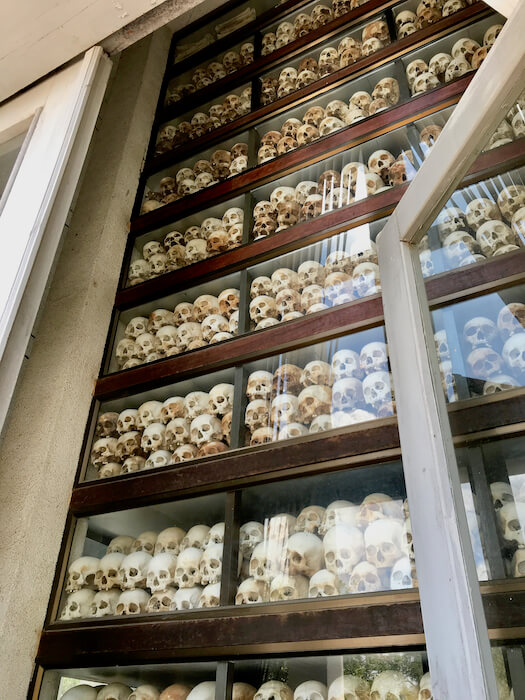
The audio tour goes in order, but you can listen and walk as you would like. There is also a film that is worth seeing.
To get to the Killing Fields, hire a tuk-tuk for the day (if there’s 2 or more of you) or get a hop-on hop-off ticket, the bus takes you to both sites.
Address & Hours: Choeung Ek Genocidal Center (aka Killing Fields) – 30 min ride from the Genocide Museum, US$3 entrance fee includes audio tour, 8am-5pm
Day Trips from Phnom Penh
Sambor Prei Kuk
Sambor Prei Kuk is an archeological site that is older than Angkor Wat. It is 3 hours by bus or car from Phnom Penh. We did this as an overnight trip. For details about how to go to Kampong Thom, Best Day Trips Phnom Penh Unique Day at Kampong Thom.
Phnom Tamao Wildlife Rescue Center
Phnom Tamao Wildlife Rescue Center (36 KM 90 minute by car) has rescued more than 1200 animals from poachers it is a great family activity. Phnom Tamao has the largest number of Sun Bears rescued from poachers. The one-day Bear Care Tours give visitors the opportunity to go behind the scenes and help take care of the bears. It is 25 miles (40 KM) from the City.
Oudong
Oudong was the capital of Cambodia from 1618-1866 and is one of the most sacred places in Cambodia. There are 500+ steps to the top where you fill find Pagodas and Stupas for some of the Cambodian Kings. There are great views of the countryside from the top. It is 22 miles (44 KM) from Phnom Penh.
Koh Dach (Silk Island)
Koh Dach, also called Silk Island, is only 6 km from Phnom Penh and can be done as an afternoon trip. After a short tuk-tuk ride, you’ll hop on a boat to get to the islands. You will see the Cambodia countryside and the Silk Weaving Center. You’ll get a chance to see the weaving process and purchase some items to bring home.
Kampong Cham
Kampong Cham has the longest bamboo bridge in the world and French colonial architecture. It is more of a quiet, off-the-beaten-track place with very few tourists. (2-3 hour drive).
We chose to stay overnight at Kampong Thom to visit Sambor Prei Kuk.
Phom Penh 5 Day Itinerary
Below are suggested itineraries for Phnom Penh for a trip of 1 day to five days. 1-2 days in Phnom Penh will be a whirlwind and you will have to carefully choose what you will and will not do. Three days and more allows for time in in the city and a possible day or half day trip. Five days will give you time to get to know Phnom Penh and have some time in the countryside.
1 Day in Phnom Penh Itinerary
If you only have one day, you’ll need to decide if you want to go to the Tuol Sleng Genocide Museum and the Killing Fields. It will take at least 5-6 hours to do both on the same day.
- Rent a tuk-tuk to the Museum and Killing Field
- Then Go to the Royal Palace (only open until 5 pm and you need 2 hours).
- In the Evening, visit the Night Market
If you don’t do the Museum and Killing Fields,
- Start out at the Royal Palace
- Then to Wat Ounalom or Wat Phnom
- Central Market
- Sisowath Quay
- Night Market
2 Days in Phnom Penh Itinerary
- On your first day, go to the Genocide Museum and the Killing Fields
- You will need a break after that
- Got to the Night Market in the Evening
Second day:
- Royal Palace
- Wat Ounalom
- Daughters of Cambodia
- Sisawath Quay
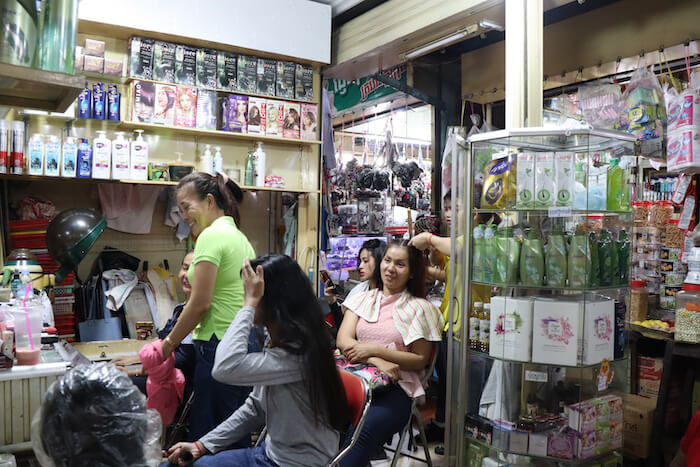
3 Days in Phnom Penh Itinerary
- You have time to slow down and savor Phnom Penh. In addition to the two day itinerary,
- Wat Phnom
- Go to Silk Island (see below)
4 Days in Phnom Penh Itinerary
- Do the Three day Itinerary. Take it a little slower. Spend more time walking the City and going to the markets.
- Do one of the Day or Overnight Trips
5 Days in Phnom Penh Itinerary
- Do Days 1-4 above, including a one-day trip out of Phnom Penh.
- Al-Serkal Mosque
- Go Street Art Hunting
- Finish your souvenir hunting at the Central Market, Russian Market or Night Market
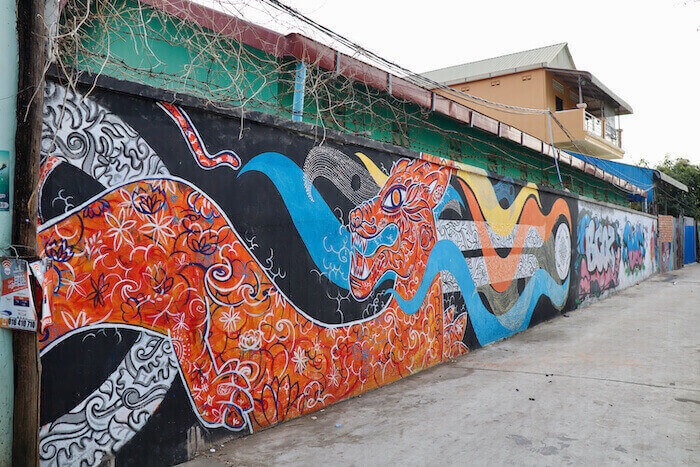
Street Art in Phnom Penh
Street art in Phnom Penh is evolving and very raw. It can be challenging to find. One of the main areas is on Street 93 in the Boeung Kak District. There is also an area near Callamet Hospital. In addition, you can stumble upon alleyways and walls with art around the city. For a couple of years, the Cambodia Urban Art Festival took place in December in Phnom Penh. The most recent festival was canceled due to lack of funds.
Here is where to find the best street art in Phnom Penh.
Getting Around Phnom Penh
Traveling around Phnom Penh can be challenging. Tuk-tuks are widely used and you can use Grab to call a tuk-tuk. The drivers mainly speak Khmer and some do not know the city as well as we feel they should. Also, if you are hailing a tuk-tuk on the street, negotiate the price before you get in. They will usually quote you in US$.
Grab App and Tuk-Tuks
We highly recommend downloading the Grab app. It is widely used in South East Asia since Uber is not available. There are different versions of the tuk-tuk in Phnom Penh. There’s remorgue which are larger and can seat 4 adults and then there’s moto which is essentially an oversized scooter that sits 2 adults besides the driver. Tuk Tuk drivers rely heavily on the Grab GPS which may not always be accurate. It is best to have a sense of where you are going and use a landmark as a reference. The Grab app will also set the price and you won’t have to negotiate the fare.
Hop On Hop Off Bus
Unlike most HOHO buses in other cities, the one in Phnom Penh takes you only to Tuol Sleng Genocide Museum and the Cheuong Ek Killing Fields. They pick up from certain hotels (call the bus company more than 24 hours in advance to arrange) and drop off after the tour.
Entrance fees to the museum and killing fields are not included. You will be paying for an airconditioned bus to take you to these 2 places and does not include any city tours at all.
Address & Hours: Cost is US$15.00 and you can buy from Viator or GetyourGuide in advance.

Where to Stay in Phnom Penh
There are many areas to stay in Phnom Penh. Some of the more popular areas for tourists are:
National Museum
Riverside
Wat Langka
Wat Botum Park/Independence Monument
Traffic can be very heavy around the Central Market or Russian market neighborhoods
The Wat Langka area is has a lot of restaurants and bars. It is a more residential area and is closer to the major attractions like the Royal Palace. We will stay in that area if we return to Phnom Penh.
For this trip, we pickedRiverside because it is quieter and we wanted to be near the Tonle Sap River and Sisowath Quay. We stayed in two hotels in Phnom Penh. TAO residence is one of the best hotels in Phnom Penh.
TAO Residence
The TAO Residence is a beautiful boutique hotel with contemporary furnishing. They mainly serve business travelers. We had a huge terrace facing the Mekong. The rooms are beautiful and well appointed. There’s a wet bar with alcohol, soda, chips and a small fridge. The staff is friendly and helpful. The rooms are soundproofed, but the music and sounds on the street can sometimes be heard late at night. There is a strong wifi signal in the room.
Address: St 144 corner of Sisowath Quay. At US$58.50/night (no breakfast),
Riverview Cambodia
Riverview Cambodia is a clean and small boutique hotel with rooms on 3 levels (no elevator). Our suite, on the 3rd floor, came with a balcony that faced the night market and has side views of the Tonle Sap River. The hotel provides 2 complimentary bottles of water and a small fridge with the usual beer and soda.
The room was spacious with a sitting area, a desk and a separate toilet (from the bath). The 2nd morning we had no hot water and the hotel responded quickly to fix the situation.
The hotel is well located with the night market across the street. The music in the night market ends at 11 pm and can be heard in the rooms that face the market.
Address: #2 St 108, Phnom Penh (formerly known as River 108). Breakfast is included in the rate of US$55/night.

Where to Eat
You can find almost anything to eat from French to Chinese to Indian to Khmer food in Phnom Penh. Prices are more expensive than other Southeast Asian countries like Vietnam but less expensive than Singapore.
Chez Gaston
Chez Gaston is one of the best French restaurants in Phnom Penh. The Duck breast is well known and is very good. You can have a three-course meal at the bar for $10 or at a table for $13, including a glass of house wine. Simone Seemak, the chef came out to meet us. She was trained at a French restaurant. If you are lucky, Bruno the owner will stop by to perform magic tricks during your dinner. We especially recommend trying his crème brulee which is made with a special French caramel. Chex Gaston is cash only.
Address: 76 Street 15, Phnom Penh
Daughters of Cambodia Visitor Center
As mentioned earlier, Daughters of Cambodia has an excellent café. They serve food and pastries. The pastries were very rich and the food is excellent. There is a balcony overlooking Sisowath Quay. They close at 5 pm, so best for lunch or an afternoon treat.
Address: 321 Preah Sisowath Quay,
Mok Mony
Mok Mony is a Khmer restaurant in Phnom Penh. The grilled Betal Leaf with marinated beef is well seasoned and tasty starter. We also had the chive stems, boneless duck and fish/crab amok. The fresh fruit drinks are heavenly. Take note that there is ice in the drink if you are avoiding ice. The bill was $35, a bit pricey, but worth it. If you are interested in Khmer food in Phnom Penh, Mok Mony should be on your list.
Address:
Night market
We recommend that you do at least one meal at the Night Market. Cambodia street food is an experience that you’ll be sharing with the locals.
After walking around the market, go to the back behind the stage to find the food stalls. At some of the stalls, they prepare noodle dishes. At others, you select items (fish, meat, vegetables) and they cook for you.
You’ll pay for your food and then find a place to sit on the mats near the food stalls. The vendor will bring the food to you. Do take off your shoes before stepping on to the bamboo mats. We enjoyed our meal at the night market.
Address:
Accessibility
Accessible travel can be challenging in Phnom Penh. Many of the sites have limited wheelchair accessibility. The National Museum, for instance, is not accessible. Other places, like the Genocide Museum and Killing Fields, are partially accessible. Many hotels have stairs and lack elevators.

LGBTQ
Phnom Penh has a very active LGBTQ scene. As usual, there are many more hotels and bars that cater to men than women. It is not illegal to be gay in Cambodia, but there is not much legislation in support of LGBTQ+ populations. King Norodom Sihamoni has publicly stated that he supports same-sex marriage legislation. The first Pride parade was held in Phnom Penh in 2003.
There is a long history of transgendered prostitutes (“ladyboys”) in Cambodia. The Khmer language has a term for a third gender—ktuey—though culturally it is not accepted.
Rainbow Community Kampuchea is the LGBTQ+ rights organization in Cambodia.
We wanted to visit the L Bar, Cambodia’s first lesbian bar, while we were there but it did not appear to be open.
Family Travel
Phnom Penh has a number of family-friendly attractions. The Phnom Tamao Wildlife Rescue Center, the Royal Palace, the Russian market, a cruise along the river and Sisowath Quay are all good spots for families. There is also Kid City, an indoor entertainment center. Riding in a tuk-tuk can be great fun for kids. The Genocide Center and Killing Fields should be avoided with young children.
Getting to Phnom Penh
Phnom Penh is just a little over a 2hour flight from Singapore. Airfare on Silkair was S$259/pn (US$192/pn) and includes check-in bag allowance of 30kg. We took carry-on bags and didn’t check any luggage.
It is a short flight from Siem Reap, Hanoi, Ho Chi Minh City, and many other Asian cities. There are buses that run from Siem Reap to Phnom Penh (6 hour ride).
We took a taxi from Pochentong Phnom Penh International airport for US$15 (tuk-tuk will cost less but slower and dustier) to our hotel, Riverview Cambodia. The taxi driver wanted US$18.00 but we bargained and he then produced a receipt for US$15.00. On our return trip, we ordered a Grab taxi.
Traffic near the airport can be bad, so make sure to leave extra time to ensure that you don’t miss your flight.
Currency in Phnom Penh
It is not necessary to change Cambodian Riel as US$ is accepted everywhere. You pay in US$ and will get the change back in local currency which can be used to buy street food.
Beware vendors in markets will offer terrible rates.
They only accept current US currencies. We were given an older US$10 note as change at the Royal Palace after purchasing our entrance fees and could not use the bill anywhere in Cambodia.
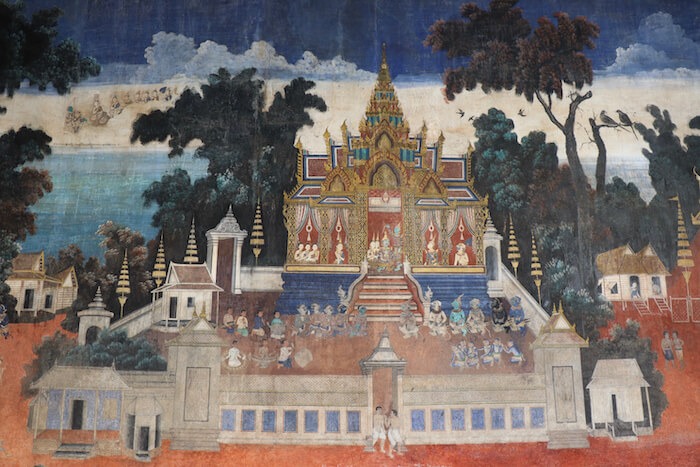
10 Tips for Phnom Penh, Cambodia
- Carry small US$1 bills – it’ll make your life so much easier
- Download Grab app for getting around
- Get a local SIM card as our international ones did not work in Cambodia
- Upon landing you will see signs in the airport for a free SIM card. The SIM card is free but it costs US$5 to activate the service.
- If your phone is locked, get a pocket wifi as not many places have public wifi.
- Try to bargain by starting at half the price quoted
- Do try street food especially if it is cooked and if you see a line
- Bring a mask especially for traveling in a tuk-tuk (there is a lot of construction in Phnom Penh and streets can be dusty)
- The street numbers can be very confusing and do not run in a grid. Numbers do not run consecutively. If you find yourself on street 102, the next street may be numbered 106.
- Similarly, there are multiple streets with the same number. Make you get the cross street so you know exactly where you are going. It’s good to identify the nearest landmark as a reference point.
- Most of the tuk-tuk drivers speak only Khmer. Ask your hotel/BNB/Hostel to write the name and address of where you are going in Khmer. You should also download a translation app on your phone.
- It is cheap to take a Grab tuk-tuk and generally the best way to explore the city.
- If there are 2 or more of you, it may make sense to hire a tuk-tuk remorgue. Bargain with them for a day tour fare.
Interested In Phnom Penh? Any other Questions that we haven’t Answered?
Travel for Life Now is a participant in the Amazon Services LLC Associates Program, an affiliate advertising program designed to provide a means for sites to earn advertising fees by advertising and linking to amazon.com. Amazon and the Amazon logo are trademarks of Amazon.com, Inc. or its affiliates.
Please Pin and Share





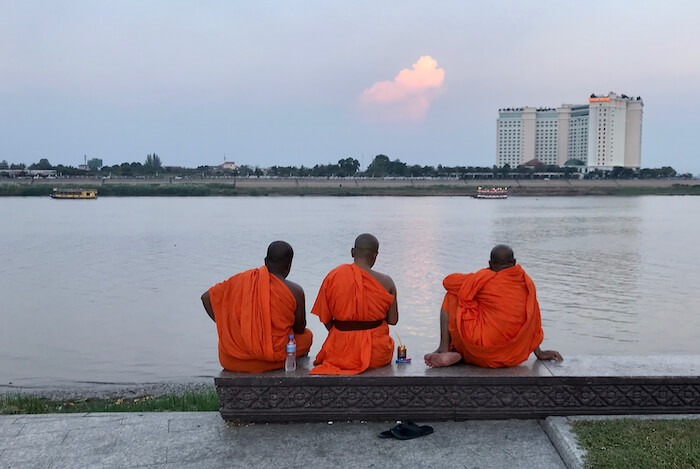
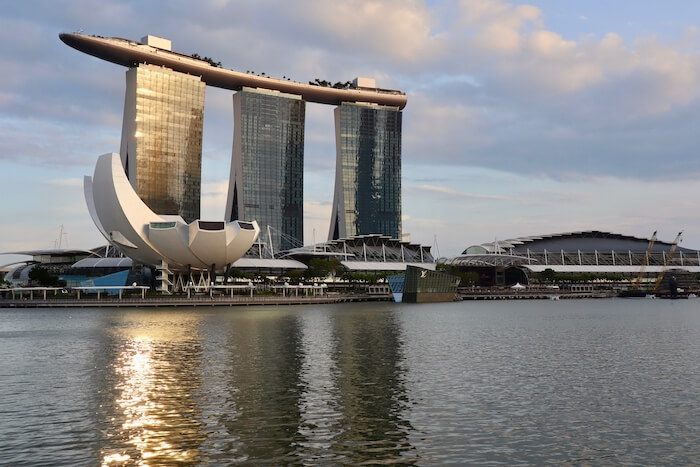
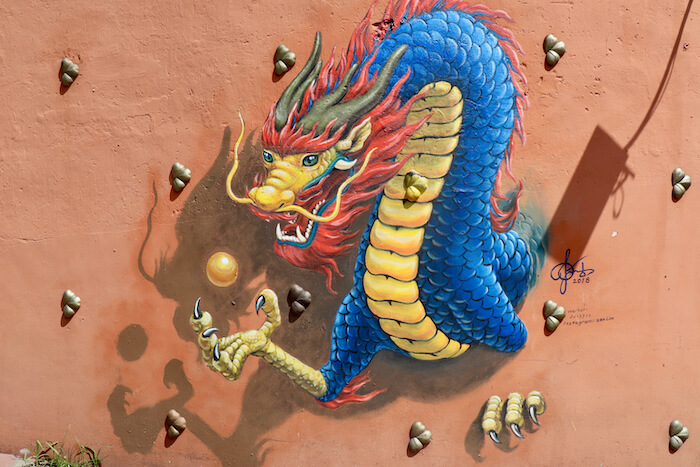


Thx for this comprehensive post featuring Cambodia and your Phnom Penh itinerary. It is an area I’ve not yet visited, but would like to.
Such a great and detailed guide! I’ve only been to Siem Reap as a 2-day trip from Saigon which we’d decided to do last minute. I loved Siem Reap but next time I will definitely go to Phnom Penh. You’ve managed to include everything! great guide!
What an awesome, informative post! I am bummed I didn’t visit Phnom Penh and only saw Siem Reap. It’s an amazing country I would love to return to!
.Such a thorough post, so useful for planning. I went to PP and Siem Reap in 1994 when tourism was just beginning in Cambodia, I’ll never forget that trip; it was incredibly special. I went alone and was often alone at many of the sites in Siem Reap! I’d love to go back again, to see the differences but I also don’t want to tarnish those incredible memories from back then.
Phoebe,
We went in 2002 and it was still possible to find ourselves alone at a temple at Angkor Wat. Not so true anymore. We debated going back to Siem Reap but decided against for the same reasons.
Sue
This is a serious guide. I think it could be cool to hire a guide to give you the 411 then apply this. I know nothing about Cambodia!
I love Cambodia. I didn’t get to Phnom Penh yet, but I plan on it one day. I love how all the cities have that unique mix of modern and traditional. This is a great 5-day itinerary for anyone– those who have explored some of Cambodia and those venturing there for the very first time,
Stacey,
Thanks for your comments. There is so much to do in Cambodia. we hope to go back many times. As you say, the mix of traditional and modern is very interesting.
Sue